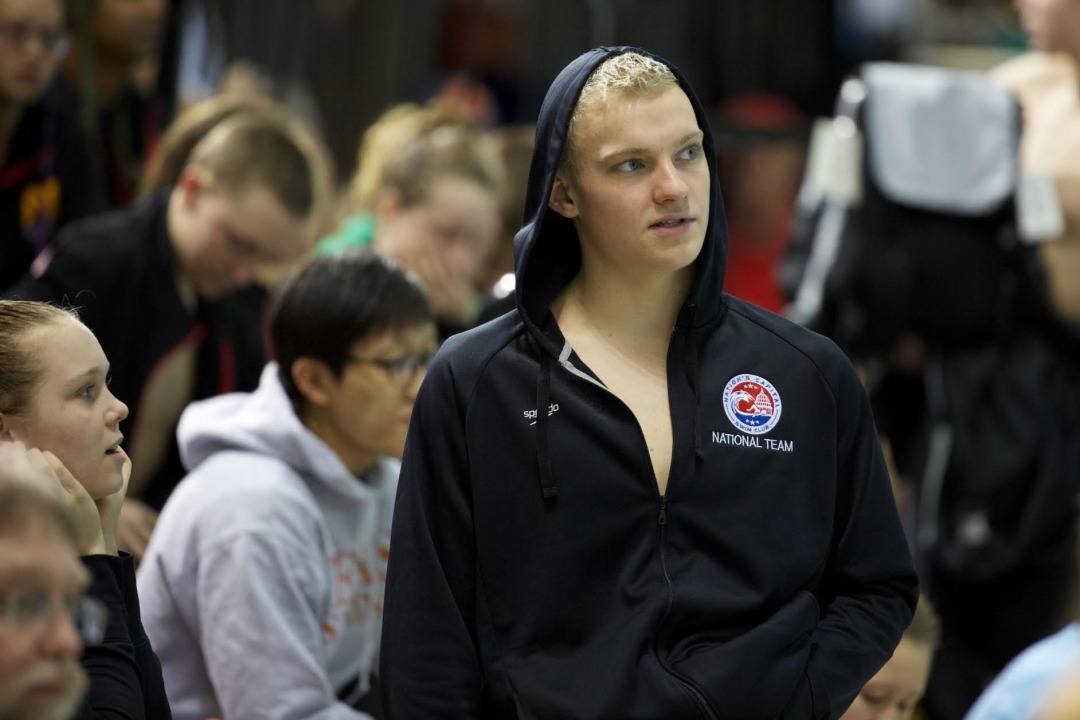NCAP’s Andrew Seliskar has broken through and set a new National Age Group Record in the 17-18 boys’ 200 yard butterfly on Saturday evening at the Tom Dolan Invitational, swimming a 1:41.33 in the University of Maryland pool.
That broke Shields’ 1:41.52 that he did as the NCAA runner-up when he was a freshman at Cal in March of 2010. Seliskar will begin his NCAA career at Cal in the fall of 2015.
Seliskar’s best coming into finals was a 1:41.72 that he did in prelims, tying him with Michael Phelps for 2nd-best all-time on this list. Coming into the meet, he was a 1:42.55 back in 2013.
While there are plenty of statistics floating around about how much, or how little, National Age Group Records, mean, Seliskar is the latest in an illustrious line of National Age Group Record holders in this particular event. The last three record holders in the event before Seliskar have all won at least one meaningful U.S. long course National Championship in the event, and two of the three have held the World Record.
The progression:
- 1987 – Mel Stewart, 1:41.78
- 2003 – Michael Phelps, 1:41.72
- 2010 – Tom Shields, 1:41.52
- 2014 – Andrew Seliskar – 1:41.33
A comparison of splits show that Seliskar attacked this race in a way that neither Stewart nor Phelps nor Shields dared to when setting their records – Seliskar was nearly a second faster on his first 50.
- Stewart ’87 – 22.99/25.39/26.20/27.20 = 1:41.78
- Phelps ’03 – 23.10/26.21/26.46/25.95 = 1;41.72
- Shields ’10 – 23.01/25.76/25.56/27.19 = 1:41.52
- Seliskar ’14 – 22.13/26.08/25.82/27.30 = 1:41.33
Byt he 100, his split was very similar to that of Stewart’s, but was still a pace that nobody could really match taking out. Seliskar held on well through 150 and paid dearly to finish the race.
Seliskar will still be 18 until September 26th, 2015, meaning that if he chooses, he could have a few more opportunities to break this record again.
A full meet recap will be published after the session.

RACE VIDEO LINK
https://www.youtube.com/watch?v=nGvgJg7RF6o
😎
This kid tho!!
My first thought is that Mel’s, Shields’, and Seliskar’s times were set by boys who are young and gaining speed quicker than they can really learn to control it. As they learn to work within their capabilities, we see splits becoming more even and controlled. My second thought is that in this particular race, Andrew Seliskar set his sights a little too high (American record) and couldn’t hold on past the 150 mark. Shields’ 1:39.65 splits were 22.2, 25.7, 25.7, 25.8. Phelps’ 1:39.65 was 22.0, 25.4, 26.0, 26.0. Both fairly similar swims, no split being separated by more than 0.3s. Seliskar’s race mirrors the first three splits with 22.1, 26.0, 25.8 but then falls way off the mark with 27.3.… Read more »
He didn’t pay that dearly on the last 50 – his split’s pretty comparable to Stewart and Shields.
They paid for it, too. 2nd and 3rd 50’s for all of them were between 25.3 and 26.2. Final 50 for all of them was 1.00-1.63 slower than the third. The only one who got into that range with a less aggressive start was Phelps.
He sure wanted it to be faster. If you watched via the live feed, you got the sense he was a bit disappointed. I sorta like that attitude, although I do hope he is appreciative of what he has accomplished.
And unlike shields, Seliskar did it over the water instead of under it.
Ehhhhh…. Seliskar’s underwaters are a huge part of his stroke.
I can’t tell if you’re like, criticizing here.
Whitley wins in 1:55.52